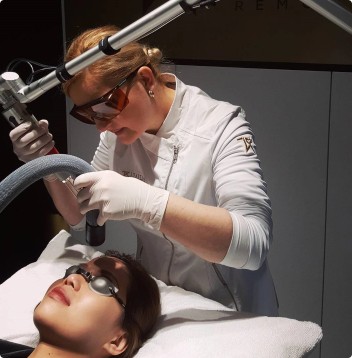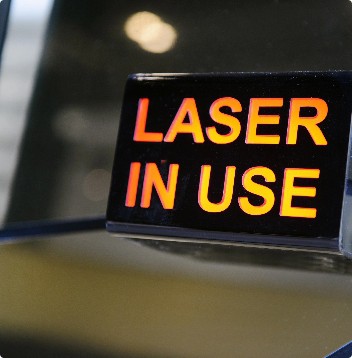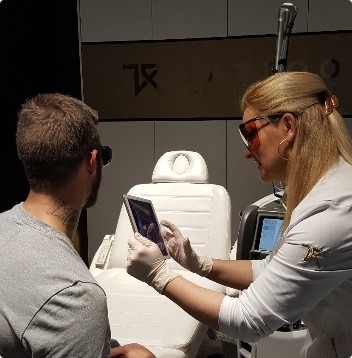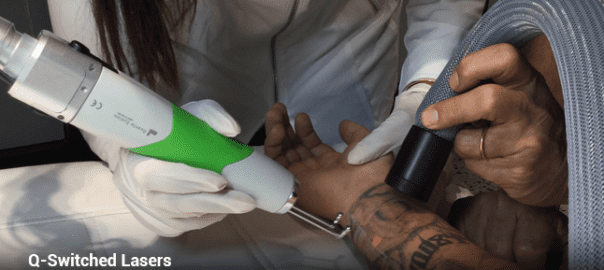Thinking of getting your tattoo removed but not sure how laser tattoo removal works?
For many people, tattoos are a way of expressing themselves and their feelings. For others, they're just something that looked cool at the time. Whatever your reason for getting one, there's always going to be an element of regret present when you realise how much effort it might be to remove them if there’s something about the tattoo that you're just not happy about, like placement or error.
But, don’t worry! The myth about us burning or scarring your skin is, well, exactly that: a myth.
With advancements in technology, laser tattoo removal has become an increasingly popular option for people wanting to remove their tattoos permanently - and it isn’t as painful as people believe it to be.
So, we are here to break down how laser tattoo removal works so that you can make an informed decision before starting the removal process.
Here’s what you need to know:
Tattoos and Skin
Before getting into how laser tattoo removal works, let’s look at the three layers of skin.

1. Epidermis
“Epi” means outer, so the epidermis is the outer layer of the skin.
Melanocyte cells are found in the epidermis, and they produce the melanin pigment that gives skin its colour. Not to alarm you, but humans shed 500 million skin cells from our epidermis daily.
2. Dermis
Below the epidermis is the dermis. Here lie hair follicles, sweat glands, and blood vessels.
Our sense of touch is thanks to the nerve endings in the dermis.
3. Hypodermis
“Hypo” means lower, so the hypodermis (also known as the subcutaneous tissue) is the lowest part of the skin and attaches the skin to the body.
It’s made of fat to insulate the body and protect the bones and muscles beneath it, as well as connective tissue, collagen and elastin.
When you get a tattoo, the needles inject deeper than the epidermis. Because the skin’s outer layer is constantly shedding, the ink would disappear within a few weeks if the tattoo were in the epidermis.
Instead, the ink is injected into the dermis layer.
Remember, our nerve endings are found in the dermis, and that’s why getting a tattoo often hurts a bit. The ink particles spread into the dermis to form the tattoo.
Tattoo Ink Particles and White Blood Cells
Once the tattoo has been performed on the skin, it takes 8-16 weeks to be permanent.
This process consists of a few steps:
- Ink particles containing tattoo pigment are injected into the dermis layer of the skin.
- The immune system sends white blood cells to eliminate these foreign intruders.
- Ink particles are larger than white blood cells, so the white blood cells can only escort small ink particles to the liver to be excreted.
- The dermis traps and encases the larger ink particles that stay behind. The pigment can’t escape nor be absorbed by the body, so it remains as is.
Laser Tattoo Removal Procedure
To remove a tattoo, you need to break the ink particles into small enough chunks that the white blood cells can absorb and transport them to the liver.
Tattoo removal lasers send light energy into the skin using pulses. These are both extremely hot and extremely fast. The breaking of an ink particle requires expansion, and this is achieved through heat. Then, for it to crack, half of the particle has to remain cool.
Think of pouring boiling water into an ice-cold glass: the heat of the water causes the inner layer of the glass to expand, but the outer layer takes much longer to absorb that heat. The different amounts of expansion cause so much pressure that the glass cracks.
For half the tattoo ink particle to remain cool, the pulse of the laser needs to be both very narrow and very fast so that only half of the particle is heated up. Like with the glass, the opposing heat and cool shatter the ink particle into bite-sized pieces for the white blood cells to transport.
This process of removing tattoos is called photothermolysis.

Colour Tattoo Laser Removal
Tattoos with different colours require different laser wavelengths as colour pigments respond to light energy differently. The wrong wavelength will be ineffective as the ink particle won’t react to the laser or shatter into small pieces.
There are three primary laser wavelengths in nanometers (nm). A single nm is one-billionth of a meter.
- 532nm, which targets red, yellow, orange and pink
- 694nm, which targets bright blue and green
- 1064nm, which targets black, purple and other dark pigments
Multicoloured tattoos require a variety of wavelengths. At the Tattoo Removal Institute, we have an all-encompassing Tri Wavelength Laser System. This is the only laser tattoo removal system worldwide that can produce three true laser wavelengths from one machine.
Does Laser Tattoo Removal Hurt?
Because laser technology heats the particles, a common misconception is that the patient will feel a burning sensation. This is untrue because even though the particles are heated to thousands of degrees, it happens very rapidly.
The laser is specifically directed at the tattoo ink and doesn’t burn the surrounding tissue.
Instead, patients will experience an instant “shock” feeling from the laser pulse, often described as the feeling of being snapped by a hot rubber band. Rather than the prolonged feeling of burning, this shock vibration lasts merely a few second.
During your consultation with us, your laser technician will also discuss numbing cream with you as an additional option.
For further peace of mind, the Tattoo Removal Institute uses the Koolio Optimal Air Cooling System, which has been reported to reduce discomfort by 80%.
The Laser Tattoo Removal Process From Start to Finish
The laser tattoo removal process will look different for everyone, thanks to various factors:
- every tattoo is different;
- every tattoo artist is different; and
- people’s skin types are different.
These are some of the factors that contribute to how long it will take for laser tattoo removal to be successful.
Laser tattoo removal can require multiple treatments. This is because not all tattoo ink can be broken up into small enough chunks within one treatment session.
The tattoo ink closest to the dermis surface will absorb the laser light energy and shatter first. Then the immune system goes through the process of flushing out those particles. Once they have been removed, the practitioner can commence with the second tattoo removal session. This is why you have to take a break between consultations, to allow the breakdown process to happen.
Every laser tattoo removal treatment will penetrate deeper and deeper into the dermis until no more ink remains.
Sessions are conducted every 6-8 weeks minimum. Some people experience significant fading after as few as three sessions, but it differs for everyone. Most people run the course over a few months until they are satisfied with the fading of their former tattoo.
Other Tattoo Removal Methods
Patients are advised to begin their tattoo removal journey using laser treatments, not leave it as a last resort. Many alternative tattoo removal methods leave patients with intense scarring and changes in skin pigmentation, which hinder the laser tattoo removal process.
- Dermabrasion, a sandpaper-like technique, painfully removes both the epidermis and dermis layer of skin. Understandably, this is excruciatingly painful, and the resulting scar is often even worse than the unwanted former tattoo.
- Tattoo removal using acid is as bad as it sounds - acid is used to burn off and dissolve several layers of skin. This can result in chemical burns and permanent scarring.
- Surgically removing a tattoo sounds a lot more glamorous than the reality: literally cutting your tattoo out of your skin. This also inevitably leads to scarring, but surgeons are sometimes unable to cut deep enough into the dermis to remove all the ink pigmentation anyway.
- These procedures are a bit crazy to most people (and we can understand why!), so a common choice instead is over the counter topical tattoo removal creams. Don’t be fooled, though, as some of these creams can cause more damage than any other method of getting rid of a tattoo.
Check out our article that looks into tattoo removal cream and why it scientifically doesn’t make sense! Anything done at home is a huge risk. You should always seek the assistance of a trained professional.
Key Takeaways
Laser tattoo removal is effective because, unlike other methods, it can reach the dermal layer of skin where the tattoo ink pigmentation is.
Lasers pulse light energy into the skin, heating the cool ink particles just enough to make them shatter. The body then excretes the small fragments.
Unlike other methods of removing tattoos, laser therapy is not an aggressive procedure that results in blatant scarring.
While it takes a substantial amount of time to be successful, it is one hundred per cent worth the wait.
Studies show that “Q-switched lasers are the optimal devices for removing tattoos today.” If you would like to make use of this proven method of tattoo removal, contact us at the Tattoo Removal Institute today. Our tattoo removal experts can advise on your unique journey to getting rid of the desired tattoo, as stress- and pain-free as possible.
DISCLAIMER: The information contained herein should NOT be used as a substitute for the advice of an appropriately qualified and licensed physician or other health care provider. The information provided here is for informational purposes only. Please check with a physician if you have health questions or concerns about interactions or go to the TGA for a comprehensive list of TGA warnings. Although we attempt to provide accurate and up-to-date information, no guarantee is made to that effect.








